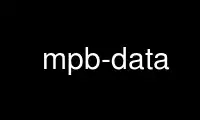
This is the command mpb-data that can be run in the OnWorks free hosting provider using one of our multiple free online workstations such as Ubuntu Online, Fedora Online, Windows online emulator or MAC OS online emulator
PROGRAM:
NAME
mpb-data - transformations of HDF5 files output by MPB
SYNOPSIS
mpb-data [OPTION]... [HDF5FILE]...
DESCRIPTION
mpb-data is a utility to perform additional processing and transformations of HDF5 files
output by MPB, the MIT Photonic-Bands program. In particular, it is designed to make the
output more amenable to visualization by reformatting it into a rectangular grid,
extending it to multiple periods, and rescaling the data.
MIT Photonic Bands (MPB) is a free program to compute the band structures (dispersion
relations) and electromagnetic modes of periodic dielectric structures.
HDF5 is a free, portable binary format and supporting library developed by the National
Center for Supercomputing Applications at the University of Illinois in Urbana-Champaign.
A single h5 file can contain multiple data sets; by default, mpb-data operates on all of
the MPB-produced datasets in the file, but this can be changed via the -d option, or by
using the syntax HDF5FILE:DATASET.
mpb-data writes its output datasets as additional datasets in the input file(s), with
"-new" appended to the dataset names. Alternatively, it can write its output to a
separate file, specified by the -o option.
Note also that, by default, the output datasets are identical to the input datasets; you
must use one or more of the options below to specify a transformation (e.g. the -r/-e and
-n options are very useful).
OPTIONS
-h Display help on the command-line options and usage.
-V Print the version number and copyright info for mpb-data.
-v Verbose output.
-o file
Write output datasets to file (for the first input file only) rather than as
additional datasets in the input file(s) (the default).
-r Output a rectangular cell with the same volume as the cell of the input data. This
option is particularly useful for visualizing data from non-orthogonal unit cells
(e.g. a triangular lattice), as otherwise the data will appear skewed or warped in
most graphics programs. This option should almost always be accompanied by the -n
option to ensure a uniform resolution.
-e x,y,z
As the -r option, but also make the first axis of the output along the x,y,z
direction (in Cartesian coordinates) instead of along the first lattice vector as
for -r.
-P phaseangle
For complex-valued datasets, this option causes the output values to be rotated by
phaseangle degrees in the complex plane. That is, they are multiplied by exp(2 pi
i phaseangle / 360).
-n n Output n grid points per lattice unit ("a"). This is useful not only for
interpolating to finer (or coarser) resolutions, but also to ensure that the
resolution is uniform in each direction (to prevent the data from looking distorted
when you visualize it).
-x mx, -y my, -z mz
This tells mpb-data to output multiple periods in the corresponding lattice
directions. to use a particular slice of a two- or three-dimensional dataset.
e.g. -x 3.2 causes the output of 3.2 periods in the first lattice direction. The
default is to output only a single period.
-m s Output s periods in each lattice direction; equivalent to: -x s -y s -z s.
-T The output has the first two dimensions (x and y) transposed. This is useful in
conjunction with the parallel (MPI) version of MPB, which for performance reasons
outputs all arrays with the first two dimensions transposed. -T can undo this
transposition.
-p Pixellized output. Normally, the input data is linearly interpolated to the output
grid, but the -p option causes it to instead use the nearest grid point in the
input data. This is useful, for example, if you want to study the discretization
of the dielectric-function representation.
-d name
Use dataset name from the input files; otherwise, the first dataset from each file
is used. Alternatively, use the syntax HDF5FILE:DATASET, which allows you to
specify a different dataset for each file. You can use the h5ls command (included
with hdf5) to find the names of datasets within a file.
Note that this option is generally unnecessary, since mpb-data can already find the
relevant dataset(s) for files created by MPB. Also, note that mpb-data treats the
dataset specified by this option as a real scalar dataset and does not include the
exp(ikx) factors when extending the dataset to multiple periods.
Use mpb-data online using onworks.net services
